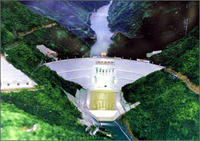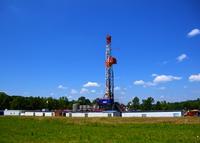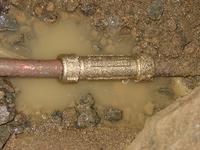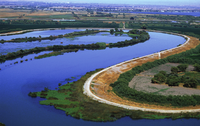-
The ground is key to cleaner environment, water
While many people recognize that clean water and air are signs of a healthy ecosystem, most do not realize that a critical part of the environment is right beneath their feet. The ground plays an important role in maintaining a clean environment by serving as a natural water filtration and purification system.
-
-
Old, faulty bores jeopardize Australia's water
Australian homes, towns, cities, farmers, and miners will rely increasingly on underground water as the country’s population grows, surface water supplies dwindle, and as droughts multiply under a warming climate. Trouble is, the authorities in charge do not have a clear idea exactly how much groundwater there is, how rapidly it is recharged — or how quickly it is being depleted. What is known is based on data largely supplied by 23,000 monitoring bores spread across the continent — more than two thirds of which are now falling into disrepair.
-
-
Projected U.S. water use to increase as climate warms
Despite increases in efficiency, water demand in the United States is likely to increase substantially in the future if climate continues to warm, new projections indicate.
-
-
China’s Mekong River dams undermine neighbors’ economies, food production

Five Chinese dams on the Mekong River’s upper portions have caused rapid changes in water level, and other adverse effects, downstream, especially in Vietnam, Cambodia, Thailand, and Laos, where millions of people rely on the river for water, food, and transportation
-
-
The Western hemisphere’s largest seawater desalination plant to be built in California

The San Diego County Water Authority announced plans to build the Western hemisphere’s largest seawater desalination plant; the plant will produce fifty million gallons of fresh water per day, enough to supply about 7 percent of the San Diego region in 2020
-
-
Evaluating fresh water sustainability in the southern U.S.
Researchers have embarked on 4-year federal research effort to evaluate freshwater sustainability across the southern United States and develop policy recommendations on what can be done to make the best use of water supplies in the face of population growth and the effects of climate change over the next ten to thirty years
-
-
Farmers upset by plan for water banking system

Depending on the depth of the drilling, it can take anywhere from two gallons to two million gallons of water to frack one well; drilling companies consumeenough water in their fracking operations to meet the needs of between 66,400 and 118,000 households; in the parched Midwest, farmers raise questions about water-use priorities
-
-
Engineers solve leaky water pipes problem

Leaky pipes are a common problem for the water industry: according to the U.K. Water Services Regulation Authority (OFWAT), between 20 and 40 percent of our total water supply can be lost through damaged pipes; developing more accurate ways of finding leaks would enable water companies to save revenue and reduce their environmental impact
-
-
Dropping lake levels in Michigan are a cause for concern
In a state that boasts 11,000 lakes, Michigan is going through a year long drought that has residents and businesses scrambling as water levels continue to decrease; the low waters is the result of low snowpack last winter and a hot dry summer this year
-
-
Groundwater pumping causes sea level rise, canceling out effect of dams
Those in charge of infrastructure protection must now worry about another source of sea level rise: water pumped out of the ground for irrigation, drinking water, and industrial use; this water ends up emptying into the world’s oceans, and scientists calculate that by 2050, groundwater pumping will cause a global sea level rise of about 0.8 millimeters per year
-
-
Groundwater pumping causes sea level rise, canceling out effect of dams
Those in charge of infrastructure protection must now worry about another source of sea level rise: water pumped out of the ground for irrigation, drinking water, and industrial use; this water ends up emptying into the world’s oceans, and scientists calculate that by 2050, groundwater pumping will cause a global sea level rise of about 0.8 millimeters per year
-
-
The American West running low on water
The American West has a drinking problem; on farms and in cities, people who live in that region are guzzling water at an alarming rate; scientists say that to live sustainably, they should use no more than 40 percent of the water from the Colorado River Basin; currently, however, they use 76 percent, nearly double the sustainable benchmark
-
-
Direct drinking water recycling could prevent floods
The use of a more streamlined process to recycle wastewater could have saved Brisbane from severe flooding in 2011 and mitigated recent flood risks in NSW, a leading water expert says
-
-
Water vulnerability in U.S. border region
The Arizona-Sonora region has been called the front line of ongoing climate change, with global climate models projecting severe precipitation decreases and temperature increases coupled with vulnerability from urbanization, industrialization and agricultural intensification
-
-
Water scarcity in California's Bay-Delta necessitates “hard decisions”

Simultaneously attaining a reliable water supply for California and protecting and rehabilitating its Bay-Delta ecosystem cannot be realized until better planning can identify how trade-offs between these two goals will be managed when water is limited
-
More headlines
The long view
Water Wars: A Historic Agreement Between Mexico and US Is Ramping Up Border Tension
As climate change drives rising temperatures and changes in rainfall, Mexico and the US are in the middle of a conflict over water, putting an additional strain on their relationship. Partly due to constant droughts, Mexico has struggled to maintain its water deliveries for much of the last 25 years, deliveries to which it is obligated by a 1944 water-sharing agreement between the two countries.
